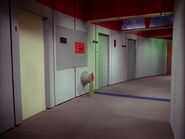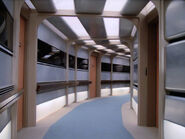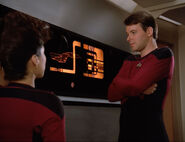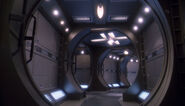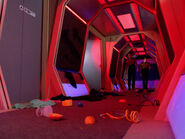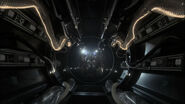HighwindBot (talk | contribs) m (Robot: Cosmetic changes !!wikia-credits fix!!) |
m (Robot: Automated text replacement (-USS ''Voyager'' +{{USS|Voyager}} & -''Voyager'' +{{USS|Voyager}})) |
||
| Line 37: | Line 37: | ||
Corridors on board starships of the {{ShipClass|Intrepid}} were all identical in concentric design. Provisions were concealed behind panels, but the ship's corridors lacked any form of padding to protect crew against injury. |
Corridors on board starships of the {{ShipClass|Intrepid}} were all identical in concentric design. Provisions were concealed behind panels, but the ship's corridors lacked any form of padding to protect crew against injury. |
||
| − | In [[2371]], on board the ''Intrepid''-class starship |
+ | In [[2371]], on board the ''Intrepid''-class starship {{USS|Voyager}}, [[Lieutenant Commander|Lieutenants Commander]] [[Tuvok]] and [[Chakotay]] took advantage of their relative seclusion in one of the ship's corridors to discuss, and air their disagreements regarding, a conflict between [[B'Elanna Torres]] and [[Lieutenant]] [[Joe Carey]]. ({{VOY|Parallax}}) |
=== Other === |
=== Other === |
||
Revision as of 08:04, 21 April 2008
- See corridor (disambiguation) for related terms.
Corridors located within starships and space stations have typically served as pathways or passageways to various stations or quarters, and as lengthy hallways through which one might access various rooms.
Starfleet
In order to maximize the use of space aboard Starfleet vessels, the corridor system is designed to provide more than simply access from room to room. Several safety and survival features are built into the walls and ceilings, as are running lights to indicate whenever the starship is operating under alert status.
Corridors on board Starfleet vessels are usually of two types: radial (those which run outward, pointing toward the outer hull) and concentric (those which lie in rings, interconnecting the radial corridors). The angled surfaces of each conceal different support structures.
Radial corridors are angled on either side. Their walls conceal a variety of supply lines and conduction systems, data networks, and power trunks. These systems are accessible by the removal of the snap-locked panels which cover them, and all are marked. The ship's concentric corridors house personnel support systems. In each corridor segment, there exists an emergency survival compartment which provides atmosphere, food and communications for one crew member; this provision is to be used should sudden decompression of the ship interior occur due to hull damage of life support failure.
On board starships in service since the twenty-fourth century, force fields can be erected in corridors to confine intruders.
Constitution-class
Corridors on board starships of the Template:ShipClass had been exceptionally wide on vessels on the original configuration. With the refit of the class came an extensive redesign of the corridors. The corridors were now color-coded for identification of deck level. The panels of those on Deck 5, which housed the crew quarters of most of the ship's officers, were covered by a layer of red padding to help protect against injury during any unlikely sudden ship movement. Most corridors on board were colored silver. Those within the engineering hull appeared blue due to different lightning arrangements within that section of the ship. (Star Trek: The Motion Picture)
Galaxy-class
Starships of the Template:ShipClass featured wide and comfortable corridors similar in arrangement to starships of the Constitution-class: concentric corridors echoed the shape of the primary hull and were interconnected with radial corridors. The latter were similar in design to those on board Constitution-class starships; the concentric corridors of the Galaxy-class, however, were more wide and allowed crew and guests direct computer-access through panels mounted against either wall of the corridors. This allowed users to be directed to their destination of choice. (TNG: "Encounter at Farpoint")
In 2364, on board the Galaxy-class starship Enterprise Dr. Beverly Crusher looked for, but failed to find, Lieutenant J.G. Geordi La Forge in a corridor when he fled sickbay while being treated for a mysterious illness. (TNG: "The Naked Now")
Intrepid-class
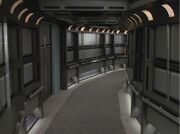
A corridor on board a starship of the Intrepid-class
Corridors on board starships of the Template:ShipClass were all identical in concentric design. Provisions were concealed behind panels, but the ship's corridors lacked any form of padding to protect crew against injury.
In 2371, on board the Intrepid-class starship USS Voyager, Lieutenants Commander Tuvok and Chakotay took advantage of their relative seclusion in one of the ship's corridors to discuss, and air their disagreements regarding, a conflict between B'Elanna Torres and Lieutenant Joe Carey. (VOY: "Parallax")
Other
A gallery of other Starfleet corridor designs:
Cardassian
Corridor on board the former Cardassian space station Deep Space 9
Corridors on board starships and space stations of the Cardassian Union reflect the Cardassian preference of balance, angles, and hard metallic surfaces and dark colors. Cardassians believe in honesty in design and wish to see the columns and beams that make up a structure rather than disguising them with cosmetic treatment. Corridors on board the former Cardassian space station Deep Space 9 reflected this design philosophy in being darker and harsher than those on board starships and space stations of the Federation Starfleet.
In 2369, Tosk tampered with an access panel in one of Deep Space 9's corridors in an attempt to gain access to the station's weapons locker. (DS9: "Captive Pursuit")
In 2373, Nog and Jake Sisko confronted Kai Winn Adami within one of Deep Space 9's corridors over her suspected role in acquiring a Willie Mays rookie year baseball card from an auction. (DS9: "In the Cards")
Romulan
Interiors on board starships of the Romulan Star Empire are spartan and functional. Thus corridors on board Romulan vessels are wide, allowing quick and unrestricted access throughout the ship. Computer panels were provided throughout ship corridors, mounted against both sides of the wall, allowing easy access to ship systems. (DS9: "Improbable Cause")
Background information
Throughout various episodes of the Star Trek franchise, starship and space station corridors have occasionally served as the sites of plot developments and action scenes enhancing the narratives.
Constitution-class
The corridors of the USS Enterprise-A as seen in Star Trek VI: The Undiscovered Country were retouched from the Enterprise-D corridors with a more metallic finish, which were in turn repainted from the original Enterprise's metallic appearance, which the sets were originally built for as part of pre-production of Star Trek: Phase II in the late seventies. These versatile sets represented dozens of starship interiors before being taken down in 1994 after Star Trek Generations, over 15 years after their screen debut in Star Trek: The Motion Picture.
Galaxy-class
The interior sets for the The Next Generation Enterprise were built over those that had been constructed for The Motion Picture. However, in order to reflect the advancements that had been made by the twenty-fourth century, according to Herman Zimmerman, who served as production designer on the show's first season, "Gene [Roddenberry] wanted softer colors, he wanted carpets on the floors, he wanted space to swing your arms. [...] It was a much more comfortable, user-friendly ship than we had seen before [...]" The corridors were only cosmetically upgraded compared to those that had served The Motion Picture. "One of the really brilliant things about Hal Michaelson's design of the corridors," recalls Zimmerman, "was the aluminum panels, which could be popped off, and behind which you find just about anything. You could find vital equipment, you could find stores, you could find a lifeboat, whatever the particular episode needed just by saying, 'We've never seen this part of the corridor before, and this is what its function is'."
All the while, the design team had to avoid being compared to a hotel. According to Zimmerman, the Enterprise-D had been called the "Hyatt Regency in space". The design team chose to avoid squareness to doors and windows. "They're all rounded, some more than others," says Zimmerman. "Everything is made of metal, of course, but its hard edge has been softened by the lines of the openings and the beam structure that we live inside, that contains us within the skin of the vessel."
Intrepid-class
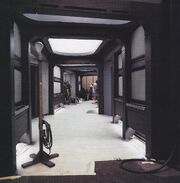
The Voyager corridor set under construction
The corridor sets for the Intrepid class starship Voyager were designed and constructed under the supervision of Production Designer Richard James. According to Wendy Drapanas, scenic artist on Star Trek: Voyager, the corridor sets which had served Star Trek: The Next Generation were extended, "so we have a longer 'walking, talking' corridor area for filming as opposed to the Enterprise. We don't have to fake it as much on Voyager as we did the corridor shots on the Enterprise. This gives the ship a longer look. Richard James also gave it more of the gray look, which brings it down in size a bit and gives it that cruiser/destroyer look."
Sovereign-class
A John Eaves sketch for the Enterprise-E corridors

The Enterprise-E corridor set under construction for Star Trek: First Contact
The corridors on board the Enterprise-E were designed under Herman Zimmerman's supervision by John Eaves. "The shape is basically a horseshoe," says Eaves, "[...] a wide U with a dropped notch in its center. Down that notch, I can a section of overhead lights; then it returns back up and makes a little alcove on the top. We also had side panels with narrow, long displays that could be used for monitors or whatever else was needed, and handrails on the inner curves. Herman [Zimmerman] wanted the panels to be removable, so that when the Borg assimilate the ship, the old panels could be replaced with 'Borg panels'. Atop those 'Borg panels' were 'Borg alcoves,' designed by Bill Hawkins. The alcoves were used to house inactive Borg, so that the corridors and decks were lined with Borg drones."
In addition, the very versatile corridors were used for hatches for lifeboats. "We made a section of corridor with all these hatches that folded up; they were vacuum-formed pieces. John Dwyer and Bill Dolan were the set dressers on the film, and John D. came up with this vacuum-formed piece he'd found that was-believe it or not-the hood off an old Camaro. And it made a perfect hatch."
"We also wound up designing a lot of 'ends,' which are pieces that you can put at the back of a particular set, to create different areas of the ship. We could take a corridor and put a Jefferies tube end piece on it, or a hatchway. And we had a lot of corridor-two full quarter-circles of it, with a couple of T-intersections and walkways. You could walk for a good five minutes from the engine room set through Jefferies tubes without ever walking out of the set "as those on the Enterprise. Perhaps most notable are the automatic doors on Deep Space 9 – large, round, and cog-wheeled, the doors roll nosily out of the way and then roll ominously shut. One gets the feeling that, while the smooth, almost soundless doors on board the Enterprise would not, and almost certainly could not, close on you, it seems likely that Cardassian safety features were not so rigorous, and that being caught in the way of one of these portals would really hurt."

